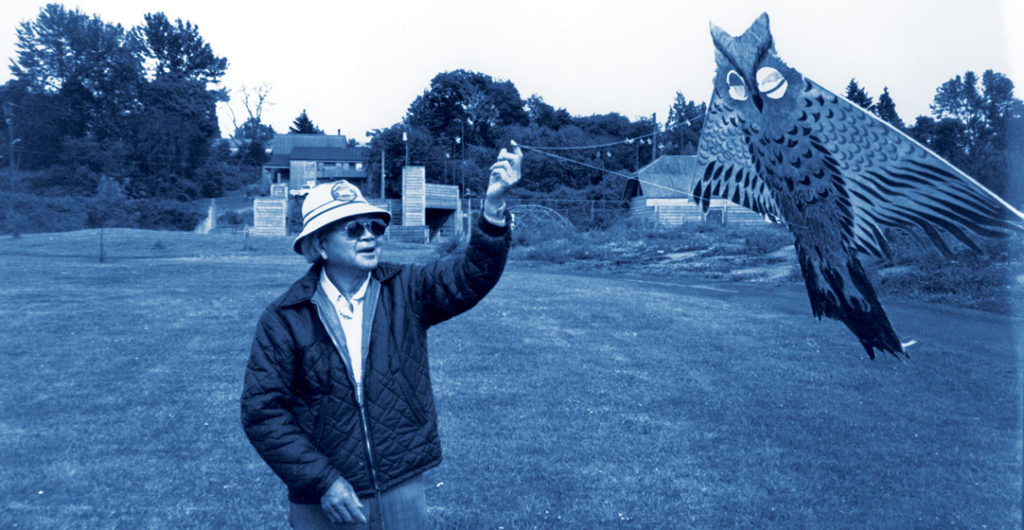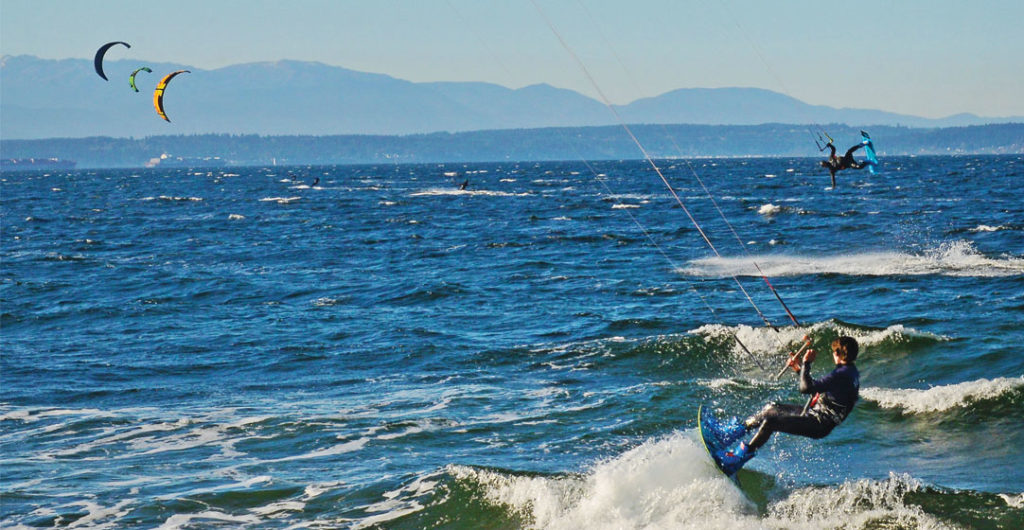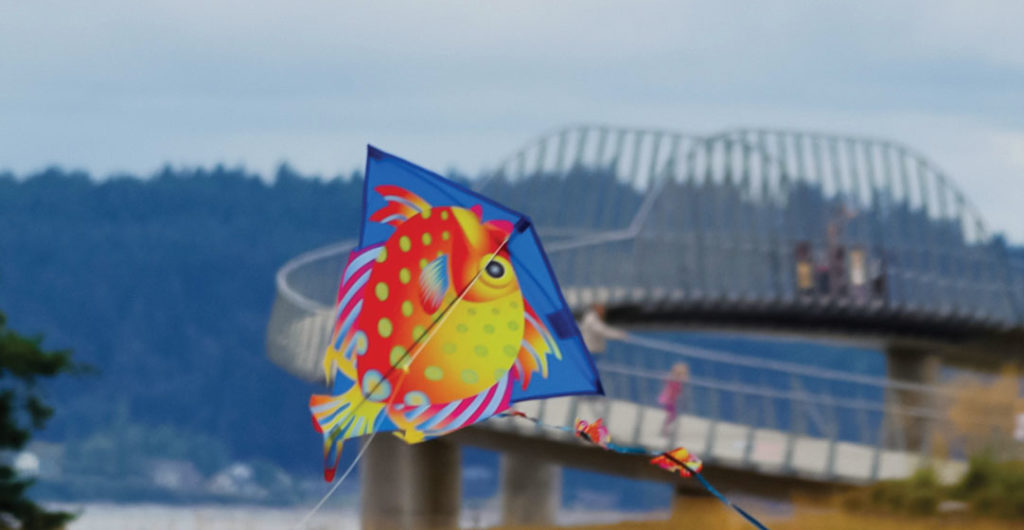Colorful Kites Allow Spirits to Soar in the Northwest
All across the Pacific Northwest are windy pockets primed to lift your sails and raise your spirits.
Amy Doran has won five American Kitefliers Association national competitions. But an even bigger reward for the Federal Way woman is the therapeutic effect she’s witnessed in her son Connor’s epilepsy. Connor hasn’t experienced a seizure in 12 years, a feat she credits to the out-of-body experience of kiteflying. “The minute you launch that kite, you’re really not on the ground anymore,” Doran says. “Kiteflying is just you and nature — and a beautiful, tethered piece of artwork.”
As kitefliers guide a winged creation through the air, feeling the power of lift and bracing for drag, many feel deep calm and focus. Each moment spent guiding these beauties in flight brings with it a chance to play with and learn from a powerful invisible force, a transformative experience that is hard to explain. “I want to say joy, but it’s so much more than that,” says Nic O’Neill, a professional kiteflier based in Anacortes. “It helps us discover new things about ourselves.”

Cultural Offerings
Although today they’re largely associated with a carefree day on the beach, kites have had quite an impact on the world. First popularized in China, they played a role in understanding electricity and were instrumental in the development of planes. Seattle’s Wing Luke Museum of the Asian Pacific American Experience and the World Kite Museum in Long Beach, Washington, have traditional Asian kites in their collections.
Blake Nakatsu, The Wing’s exhibits developer, notes that Asian kites are not only practical. They have deep cultural and spiritual meaning, Nakatsu says, because they reportedly were used to send offerings to the gods. Japanese “koinobori,” or carp-shaped kites, are hung outside of houses and flown on Children’s Day on May 5th as a symbol of courage and strength.
Some kites, like the “bang-pae yeon” or Korean shield kite, are even used in the sport of kitefighting. Their highly maneuverable bodies are attached to cotton or hemp line coated with glass to cut the lines of competitors’ kites. Closer to home, The Wing also owns 16 of the 300 kites created by the late Larry Chinn, a Chinese-American Seattle resident who worked as a Boeing mechanic for 30 years. Chinn crafted elaborate creations — elephants, octopi, peacocks — each hand-painted in traditional Chinese style. The longest kite he made was a 100-foot centipede and required several people to fly.

Wind and Water, Hills and Valleys
While intuition can help in the hunt for a strong breeze, there is some science to finding the right kiteflying location. To lift, weave, twist and roll a kite across a cerulean sky, one needs straight, consistent wind and an open area to keep it aloft.
“Ground surface has a frictional effect on the wind,” University of Washington atmospheric scientist and Washington state climatologist Nick Bond explains. “The smoother the surface, the less friction, and the winds near the ground will be that much stronger,” Bond says.
During warmer months (April through October), wind moving inland from the ocean blows forcefully but evenly and is thus perfect for kites. The cooler temperatures of the ocean increase the air’s pressure, forcing it to move inland where temperatures are higher and air pressure is lower.
On low, long, flat beaches like many on the northern Oregon coast and Long Beach Peninsula, breezes coming off the Pacific are unobstructed by cliffs, buildings and trees, creating ideal conditions. The town of Long Beach itself, in fact, is such a perfect spot that it hosts the weeklong Washington State International Kite Festival held in August, and even has an area designated for kitebuggying, where traction kites propel wind-powered, lightweight vehicles along the beach.
The same ocean dynamics play out on a smaller scale on Puget Sound and large lakes. Fort Casey Historical State Park on Whidbey Island and Boxcar Park in Everett are well-positioned for kitefliers to reap the benefits of the summer’s westerly winds whooshing through the Strait of Juan de Fuca. Further downwind, Marina Beach Park in Edmonds and Discovery Park in Seattle take advantage of these same gusts.
An imbalance in pressure also pushes the air along rivers and valleys, like the Columbia River Gorge. Higher air pressure near Portland forces strong winds toward The Dalles, which has lower pressure. Fast winds rushing through the constricting walls of the gorge like a pressure valve make areas like Hood River famous for kitesurfing, where riders skim the river on boards powered by colorful kites.
The hills of the Pacific Northwest also create strong winds because of the way air flows over the top of them. Both Gas Works Park along Lake Union and Warren G. Magnuson Park along Lake Washington in Seattle have features known as “Kite Hill,” windswept knolls with few trees that bring kite enthusiasts out in droves.

Best Places to Fly a Kite
All across the Pacific Northwest are windy pockets primed to lift your sails, and, as avid kitefliers will tell you, raise your spirits. Some are not far from home. Grassy, treeless parks intended for soccer games tend to double as a good location to catch a breeze, as they leave little room for friction-fed wind turbulence.
Scott Davis, a Puyallup kiteflying champion, regularly posts up in a camping chair alongside a group of buddies at Chambers Creek Regional Park in University Place, Washington. The park, with its wide-open fields, bayfront views and miles of walking paths, is ideal for an afternoon of gliding his dual-line delta kite, a triangular flyer with two strings to optimize control and agility.
Because of the wind’s unpredictability, inland kiteflying brings about the same kind of enjoyment as fishing, he says.
“It creates a reward in just attempting, just getting out there. You’re there; you’re in the moment. You’re anticipating, hoping, excited to see if it happens.”
Once you’ve perfected the tension in your line and learned to counteract the drag, there are a number of ways to elevate your experience. Davis recommends an unassuming patch of grass near the Orting Lions Club in Orting, Washington, to unspool the lines and take in Mount Rainier in its full glory. O’Neill, on the other hand, uses her kite as a way to add a challenge to the activities she already loves: hiking around Mount Baker and snowshoeing near Keechelus Lake.
“It’s something that I can take with me anywhere,” O’Neill says. “It’s very truly Washington. We don’t care that it rains, we still go out and play in it.”
Where to Fly a Kite
Oceanside: Long Beach; Grayland; Ocean Shore; Seaside, Oregon; Lincoln City, Oregon
River/Lakeside/Sound: Fort Casey Historical State Park on Whidbey Island; Chambers Creek Regional Park in University Place; Marina Beach Park in Edmonds; Boxcar Park in Everett; Discovery Park, Gas Works Park and Warren G. Magnuson Park in Seattle; Vista Park in Skamokawa; Frenchman’s Bar Regional Park in Vancouver; Marymoor Park in Redmond; Priest Lake in Northern Idaho; Bear Lake State Park, Idaho
Kite-Friendly Open Areas: Steptoe Butte State Park Heritage Site near Colfax; Field at Orting Lions Club in Orting; Southridge Sports and Events Complex in Kennewick; Plante’s Ferry Sports Complex in Spokane









